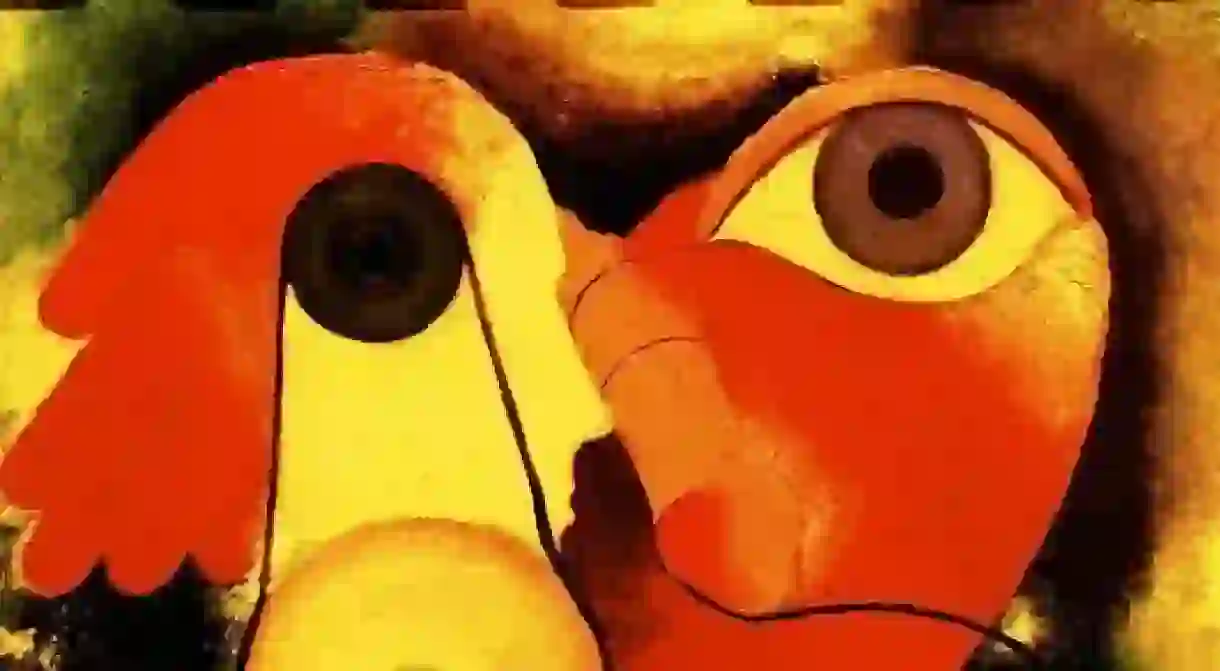Joan Miró: 7 Masterpieces You Should Know

‘Conventional painting methods should be raped, killed, murdered in favor of new expressions of the reality’ — this popular Miró quote offers an insight to the artist’s path through the Surrealism movement and his artworks between 1912 and 1983. Here are seven of Miró’s masterpieces where the traditional representation of the reality is gradually destroyed and replaced with a new imaginative painting perspective, contaminated by dadaism, cubism, abstract arts and expressionism.

The Farm (1923)
This work is considered by art critics a ‘Detailist work,’ prior to Miró’s surrealism phase (it began in 1924). The painting is a representation of Miró’s feelings about the Catalan rural landscape and his memories from the childhood spent at his family’s farm. Although the objects are still designed with a maniac attention to details, the atmosphere is unreal — the light, the blue of the sky and the distorted perspective generate a sense of mystery and emotional energy rather than a rural everyday-life picture.
Maternity (1924)
Miró is the most passionate and extreme of the Surrealists (compared to Dalì, Magritte, etc.), especially because of his strong interest in abstraction. Maternity represents the relationship between mother and child, but the figures are vaguely identified. The mother and two children become symbols and lines, with two breasts floating in the space and two abstract infants floating around them. Nothing is real apart from the feeling of a natural deep connection, strongly visible despite the absence of conventional elements of shared love between a mother and her children.
The Hunter (1924)
‘I have managed to escape into the absolute nature, and my landscapes have nothing in common anymore with outside reality […].’ If Maternity was an abstract metaphor of human elements, The Hunter is a landscape presented through an allegory of abstract elements; the hunter is a two-dimensional figure smoking a pipe and holding a rabbit and a rifle. Miró’s surrealism is now an absolute language of signs and symbols. The elements within the scene evoke the countryside of Catalonia thanks to the red and the yellow hues, and the French, Catalan and Spanish flags reference Miró’s joint fondness of his birthplace (Barcelona) and his adopted home in Paris. The word SARD takes us to Catalonia and his national dance, Sardana — a symbol for Nationalism.

Collage Montroig (1929)
Joan Miró experimented with a variety of methods and media in the course of his artistic career. Surfaces, materials, and collage techniques purely fascinated him. The artist used them as perfect expression of the unconscious. Miró’s collages are not precise, but compared to Cubism’s approach, they are a casual ensemble of elements. Montroig is a work made with conté crayon on woven paper collaged with three grey fibrous flocked paper elements, one tan particulate flocked paper element, one rust-colored particulate flocked paper element, black pebble/tar paper, wire and string. He used wire in two collages to create a 3-D line. At this stage of the artist’s path, the denial of realism was moving from an abstraction of reality to a deep exploration of the human and natural mysteries — the unconscious and the universe.
The Beautiful Bird Revealing the Unknown to a Pair of Lovers (1941)
As a consequence of the Spanish Civil War and World War II, Mirò found relief in looking at the night sky and the stars. The Beautiful Bird Revealing the Unknown to a Pair of Lovers is one of 24 drawings executed between 1936 and 1941. Colors, shapes and lines here describe the peaceful harmony of constellations and dreamlike creatures. Mirò was running away from the brutal reality of the war, especially when he was forced to move with the family from France to Mallorca, so he felt the urgency of representing an imaginative universe as much as possible — comfortable and poetic.

Triptych Blue (1961)
Denial of realism also means emptiness. The feeling of vacancy, the power of the color blue and pure geometrical shapes placed in the space are the relevant themes of the famous triptych. The blue is predominant, and it is clearly a reference to the cosmic nature. No metaphor or allegory this time, Miró investigated the significance and the balance of shapes, like lines and dots, from a geometrical perspective, a late approach that is reminiscent of the pure abstract arts of Kandinsky.
Dona y ocel (1981)
Denial of realism is not denial of reality. In all of Miró’s works, there’s the need of finding creative points of view to represent reality and human feelings, especially at the end of his career when the artist approached scenography and sculpture. Miró’s sculptures survive on the streets of Barcelona and Paris. Dona y ocel is considered Miró’s last great work, and it combines the abstraction of the shapes (the woman, the hat, and the bird) with the harmony of the hues, but most importantly, the impressive 22-meter-high sculpture exists tangibly in the urban space.
By Mariella Tilena













